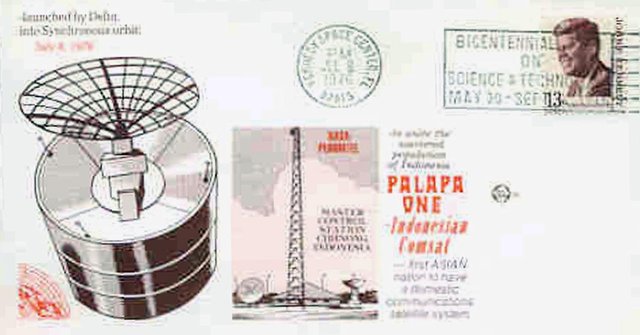Palapa, Indonesian Pioneer in Space

Today, 42 years ago. The Palapa A-1 satellite is in its orbit, 83o east, from its launch at Kennedy Space Center, Cape Canaveral, Florida, United States (US). The first Indonesian communication satellite made Indonesia the third country in the world and the first developing country to operate the Domestic Satellite Communication System (SKSD).
"This satellite system is needed to unite Indonesia and to provide education in remote areas. Palapa satellite is capable of covering a third of the hemisphere, "said director general of Telecommunications General Company (Perumtel) Willy Munandir Mangoendiprodjo when giving a speech at the launch Palapa A-1 in Florida, Kompas 10 July 1976.
Winding Road Satukan Nusantara
Having SKSD is not a dream of Indonesia that existed for a long time. In addition to minimal infrastructure and experts, the cost to build it is very large. Indonesia initially only ambitiously joined the International Telecommunications Satellite Corporation (Intelsat), a consortium of international telecommunications services built by the United States to counter the Soviet Union in space, after Suharto received advice from his economic adviser, Emil Salim.
Indonesia officially joined Intelsat and in June 1967 signed a contract with the International Telephone and Telegraph for the construction of telecommunications terminals on earth or earth stations. On September 29, 1969, Soeharto inaugurated Indonesia's first earth station.
At the inauguration, Suharto received input on the importance of SKSD from the Directorate General of Posts and Telecommunications (Postel) Major General Sohardjono. Soeharto immediately attracted and the desire for it continued to strengthen. "The President gave directions for the development of domestic satellite telecommunications implemented in Pelita II," wrote Merdeka, August 31, 1976.
Minister of Transportation Frans Seda followed up the president's direction by forming a committee to study the national telecommunications system led by Willy Munandir. The seriousness of the government increased when in 1970 the Directorate General of Post and Perumtel formed a joint team to conduct an in-depth study of SKSD. In addition to collecting telecommunications traffic data, the team also found out the number of requests for telecommunication services such as telephone lines.
In the team is Iskandar Alisjahbana. ITB lecturers have long been keen to throw the idea of using satellites to unite Indonesia and support education, information dissemination, and national development.
The desire to have SKSD became even more secure when in 1971 Munandir and Soehardjono attended the International Telecommunication Union in Geneva. They got an in-depth explanation from the Hughes Aircraft Company (now part of Boeing) about the use of satellites for domestic use and the huge potential of its business is able to cover the cost of development -Indonesia capitalizes on the potential of this business by leasing transponders to the Philippines, Malaysia and Thailand.
Once back to Jakarta, Munandir and Soehardjono immediately reported it to the president. Soeharto directed both of them to be implemented within two or two and a half years. Directorate General of Post and Telecommunication on September 4, 1973 immediately set up a review committee in charge of researching the technical, operational, and economic aspects. In conclusion: SKSD is suitable for Indonesia.
Suharto himself mentioned the use of satellites in the development of telecommunications when submitting a financial note and draft state revenues and expenditure budget 1975/76 in front of parliament, January 6, 1975. "In the course of telecommunications development, in 1975 a new satellite communications system will be established to telephone, telegraph, telex, and television broadcasting facilities, "the president said.
Munandir went straight to a number of countries to seek a SKSD development loan that cost a total of 1.4 billion dollars. Indonesia finally obtained the funds from Inter-Governmental Group on Indonesia (IGGI), Export-Import Bank, and Consortium Bank of the United States. Armed with the funds, the government signed a contract for the construction of communications satellites, major control stations, large and small earth stations with Hughes Aircraft Company, Philco Ford Overseas Services and Federal Electric International.
The government appointed Bunawan Saleh as a supervisor at Hughes manufacturing facility in El Segundo, California. This is where the Hughes work on satellite orders Indonesia which has a high dimension of 11 feet, 6 feet diameter, and weight 574 kilograms. Hughes was finally able to meet the settlement targets despite very short processing times. Palapa is one of the fastest production schedules ever undertaken by Hughes' management and engineers.
Simultaneously with satellite making time, Perumtel insured its satellite by cooperating with PT Asuransi Jasa Indonesia. The government also signed a satellite launch agreement with NASA. Through negotiations with Intelsat, Indonesia received permission point 83o BT as its satellite orbit. The orbital permit was then registered to the International Frequencies Registration Board in Geneva.
Once completed, the Palapa satellite was immediately taken to Kennedy Space Center. Exactly at 07.31 on July 9, 1976 local time (July 8 Indonesian time), Delta 2914 rocket carrying Palapa A-1 into orbit at an altitude of 30,500 kilometers.
Suharto, who witnessed the launch from broadcast television, immediately told the press that the Palapa name selection for satellites was inspired by the mahapatih oath of Gajah Mada. Suharto believes Palapa will be able to become a powerful vehicle to unite the archipelago like the oath of Gajah Mada. "I would like to extend a great appreciation to all those who have completed this Palapa project in time," Suharto said after unplugging the keris and pressing the electronic button when inaugurating the Palapa at the MPR / DPR Building on August 16, 1976.
"Palapa became an important factor that changed the national television and ethnic cultures in the archipelago. The Palapa is very useful in integrating this country, "wrote Philip Kitley in the National Cultural Construction on the Glass Screen.
Posted from my blog with SteemPress : http://mainsteem.com/info/palapa-indonesian-pioneer-in-space.html